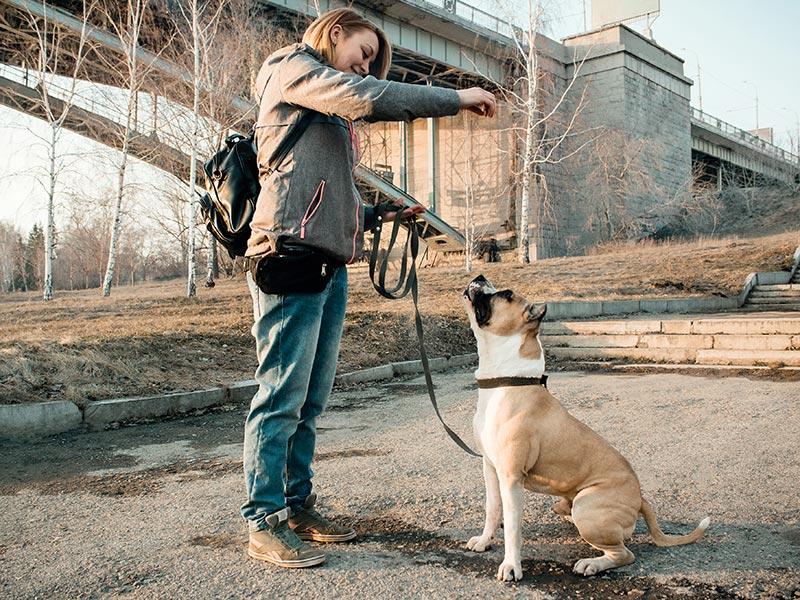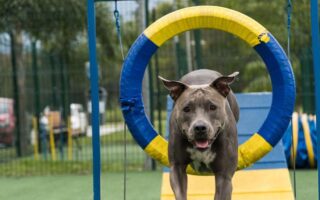In the intricate dance between humans and dogs, there exists a realm where science meets intuition — the captivating field of canine behaviorism. As our four-legged companions weave their way into the fabric of our lives, understanding their thoughts, feelings, and behaviors becomes paramount for fostering a harmonious relationship. Enter the canine behaviorist: a specialized figure equipped with knowledge and expertise to decode the subtle cues and signals that our dogs communicate. This article delves into the world of canine behaviorists, exploring their role in bridging the gap between human perception and canine instinct, the methodologies they employ, and the profound impact they can have on the lives of dogs and their owners alike. Whether you’re a pet parent seeking to understand your furry friend better or someone curious about the science behind dog behavior, join us as we embark on this enlightening journey into the mind of man’s best friend.
Table of Contents
- Understanding the Role of a Canine Behaviorist in Addressing Dog Behavior Issues
- Key Methods and Techniques Employed by Canine Behaviorists for Effective Training
- Common Behavior Problems in Dogs and Strategies for Resolution
- Building a Positive Relationship: How to Work Collaboratively with a Canine Behaviorist
- Q&A
- Future Outlook
Understanding the Role of a Canine Behaviorist in Addressing Dog Behavior Issues
A canine behaviorist plays a crucial role in deciphering and addressing various behavioral challenges faced by dogs and their owners. Unlike standard dog trainers who may focus primarily on obedience and commands, behaviorists delve deeper into the underlying emotions and motivations that drive a dog’s actions. This involves a comprehensive understanding of canine psychology, which enables them to provide tailored solutions for issues such as aggression, anxiety, excessive barking, and phobias. By employing a combination of observational techniques and behavioral assessments, they work to identify the root causes of problems rather than just addressing the symptoms.
To enhance their effectiveness, behaviorists often collaborate with pet owners, educating them on proper communication and interaction strategies to foster a healthier relationship with their pets. Their toolbox can include:
- Behavior Modification Techniques: Special strategies designed to alter unwanted behaviors over time.
- Environmental Management: Recommendations to modify the dog’s environment to prevent triggers.
- Positive Reinforcement: Using rewards to encourage desirable behaviors, encouraging a positive feedback loop.
- Training Programs: Customized plans that blend training with behavioral interventions.
In cases where behavior issues stem from medical conditions, a behaviorist may work in tandem with veterinarians to ensure a holistic approach. To illustrate the impact of their work, here’s a simplified overview:
| Behavior Issue | Common Causes | Behaviorist Approach |
|---|---|---|
| Aggression | Fear, territoriality, past trauma | Gradual desensitization and counter-conditioning |
| Anxiety | Separation, noise sensitivity, lack of socialization | Crate training, creating safe spaces, medication when needed |
| Excessive Barking | Boredom, frustration, alerting | Engaging exercises, training commands to reduce barking |
Key Methods and Techniques Employed by Canine Behaviorists for Effective Training
Canine behaviorists employ a range of innovative methods and techniques tailored to the unique needs of each dog and their owner. One prevalent approach is positive reinforcement, which encourages desired behaviors by rewarding dogs with treats, praise, or play. This method fosters a trusting relationship, promoting a happier and more engaged learning environment. Another effective technique is desensitization, where dogs are gradually exposed to stimuli that may induce anxiety or fear. This helps dogs develop coping mechanisms and reduces their reactivity over time.
Moreover, behaviorists often utilize clicker training, a method that uses a distinct sound to mark desired behaviors, paired with a reward. This clear communication aids in quicker learning. Collaborative training sessions with the owner are also emphasized, reinforcing the bond between dog and human. Additionally, some behaviorists incorporate canine body language analysis, which helps owners understand their dog’s emotions better and adjust their training methods accordingly. This holistic mix of strategies ensures a well-rounded approach to canine education.
Common Behavior Problems in Dogs and Strategies for Resolution
Many dog owners encounter various behavior problems that can disrupt the harmony of their household. Common issues include excessive barking, chewing, digging, and aggression. Each of these challenges stems from different underlying causes such as boredom, anxiety, or lack of training. For instance, if your dog is barking excessively, it might be reacting to environmental stimuli or seeking attention. Addressing these problems requires a multi-faceted approach. Begin by identifying the triggers for the behavior, provide ample physical and mental stimulation, and establish consistent training routines that reinforce positive behavior.
Effective resolution strategies often involve positive reinforcement, engaging in regular socialization, and, in some cases, consulting a professional canine behaviorist. Here are some quick tactics to employ based on specific problematic behaviors:
| Behavior Problem | Resolution Strategy |
|---|---|
| Excessive Barking | Introduce quiet commands, reward silences, and minimize triggers. |
| Destructive Chewing | Provide appropriate chew toys and redirect when caught in the act. |
| Separation Anxiety | Gradual desensitization and creating a safe space can help ease their distress. |
| Aggression | Consulting a professional is crucial; avoid confrontation and maintain calmness. |
Building a Positive Relationship: How to Work Collaboratively with a Canine Behaviorist
Building a successful partnership with a canine behaviorist requires a blend of trust, open communication, and shared goals. To create a positive environment, pet owners should:
- Be Open-Minded: Embrace new approaches and techniques the behaviorist suggests.
- Share Observations: Provide detailed insights about your dog’s behavior, habits, and triggers.
- Set Clear Goals: Collaboratively define what success looks like for you and your dog.
Regular follow-up sessions and adjustments to the training plan foster a sense of teamwork. It’s beneficial to document progress and setbacks; this can include:
| Observation | Date | Behavioral Change |
|---|---|---|
| Ignored distractions | 2023-10-01 | Increased focus during walks |
| Barked at strangers | 2023-10-15 | Reduced barking with positive reinforcement |
By sharing this information, the owner and behaviorist can refine strategies, enhancing both the dog’s learning experience and the overall bond between pet and owner.
Q&A
Q&A: Demystifying the Role of a Canine Behaviorist
Q: What is a canine behaviorist?
A: A canine behaviorist is a professional who studies and understands dog behavior, utilizing that knowledge to address behavioral issues and promote positive interactions between dogs and their human companions. They often have a background in animal science, psychology, or training and use a variety of techniques to modify behaviors and improve the human-animal bond.
Q: What kinds of behaviors do canine behaviorists typically address?
A: Canine behaviorists tackle a wide range of behavioral issues, including but not limited to aggression, anxiety, excessive barking, destructive behaviors, and fear responses. They help pet owners understand the root causes of these behaviors and develop tailored strategies to encourage positive change.
Q: How does a canine behaviorist approach a dog with behavioral issues?
A: The process often begins with a thorough assessment of the dog’s behavior and the environmental factors contributing to it. A behaviorist will observe the dog in its home setting, interact with the owner, and gather detailed history. After identifying triggers and patterns, they create a customized plan that may include training techniques, environmental modifications, and behavioral therapies to guide the dog toward more desirable behaviors.
Q: How is a canine behaviorist different from a dog trainer?
A: While there is some overlap between the roles of a canine behaviorist and a dog trainer, the key difference lies in their focus. A dog trainer typically concentrates on teaching specific commands or obedience skills, while a behaviorist dives deeper into understanding the underlying emotional and psychological aspects of a dog’s behavior. Behaviorists often deal with more complex issues that require a nuanced approach and a greater understanding of canine psychology.
Q: Can anyone call themselves a canine behaviorist?
A: No, the title ”canine behaviorist” is not regulated, so it’s essential to look for professionals with recognized qualifications and experience in animal behavior. Many reputable behaviorists hold certifications from recognized organizations, have undergone extensive training, and maintain ongoing education in the field. It’s wise for pet owners to ask about credentials and experience before selecting a behaviorist.
Q: What can pet owners do to support their dog’s behavioral progress?
A: Communication and consistency are key. Pet owners should stay engaged, apply the behaviorist’s strategies consistently, and maintain a calm and positive demeanor. Regular exercise, mental stimulation, and building a structured routine can also contribute significantly to a dog’s well-being and behavioral improvement.
Q: Are there any success stories related to the work of canine behaviorists?
A: Absolutely! Many canine behaviorists can share inspiring success stories. For example, a dog previously overwhelmed by noise anxiety might transform into a more relaxed companion after a behavior modification plan is implemented. Through observation, training, and a supportive environment, countless dogs have overcome significant challenges, leading to enriched lives for both themselves and their owners.
Q: How can someone find a reputable canine behaviorist?
A: To find a qualified canine behaviorist, pet owners can start by seeking recommendations from veterinarians, trainers, or local animal shelters. Online resources and directories of professional organizations such as the International Association of Animal Behavior Consultants (IAABC) or the Animal Behavior Society (ABS) can also help. Reading reviews and asking potential behaviorists about their specific methodologies can aid in making an informed choice.
—
Navigating the world of canine behavior can seem daunting, but with the guidance of a dedicated professional, pet owners can foster better relationships with their furry friends and create lasting harmony in their households.
Future Outlook
As we journey through the fascinating world of canine behavior, it becomes clear that understanding our four-legged companions is both an art and a science. Canine behaviorists serve as the bridge between our human lives and the innate instincts of dogs, illuminating the pathways to better communication and strengthened bonds. With their expertise, we are not just learning how to manage misbehavior or navigate the complexities of training; we are discovering the unique personality and emotional landscape of our pets. In this ever-evolving field, the shared goal remains the same: to ensure our dogs lead happy, fulfilling lives while enriching our own. So as you reflect on the role of a canine behaviorist, remember that every wag, bark, and tilt of the head tells a story waiting to be understood. Together, we can continue to unravel these narratives and foster harmonious relationships with our beloved canine companions.



